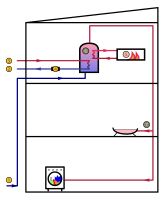
Photo from wikipedia
This paper explores how water temperature changes in a district heating system (DHS) impact the monitoring of water losses. Water volume in DHS is constantly monitored, recorded, and replenished. The… Click to show full abstract
This paper explores how water temperature changes in a district heating system (DHS) impact the monitoring of water losses. Water volume in DHS is constantly monitored, recorded, and replenished. The leakage and failure status of the DHS is often monitored through measuring the make-up water flow rate. In this paper, we present the methodology and a simplified model of the dynamics of the heating system operation, which was used to determine the profile of changes in the average temperature and density of water in the system. The mathematical model of the district heating network (DHN) was verified by comparing the results of simulation calculations, i.e., calculated values of the temperature of water returning to the heat source, with the measured values. Fluctuations in water temperature cause changes in the density and volume of water in the DHN, which affect the amount of water supplementing the system. This is particularly noticeable in a DHN with a large water volume. The study reports an analysis of measurement results of operating parameters of a major DHS in Poland (city of Szczecin). Hourly measurements were made of supply and return water temperature, water flow rate, and pressure throughout the whole of 2019. The water volume of the analyzed DHN is almost 42,000 m3 and the changes in water volume per hour are as high as 5 m3/h, representing 20–30% of the value of the make-up water flow rate. The analysis showed that systems for monitoring the tightness of the DHS and detecting failures, on the basis of measurements of the make-up water flow rate, should take into account the dynamics of water volume changes in the DHN.
Journal Title: Energies
Year Published: 2021
Link to full text (if available)
Share on Social Media: Sign Up to like & get
recommendations!